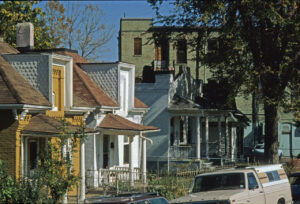By Rebecca A. Hunt
What became the town of Highlands grew out of two earlier neighborhood developments, Potter Highlands and Highland Park. This month I will give you the history of Highland Park and the origins of the town of Highlands.
Highland Park and Potter Highlands
In the 1870s, there was a new urban planning trend that envisioned and built neighborhoods designed to bring in specific demographics. Cities like Chicago and New York began to create the first subdivisions aimed at those who had a common culture based on Anglo-American, upper and middle-class economic status and values.

When William Jackson Palmer and William Bell created Colorado Springs, they planned for their neighbors to be those who came searching for an elite community with homes with a mountain view.
These founders and financial leaders of the newly developing Rocky Mountain Front Range, felt that they deserved to choose where, how and with whom they lived. In Denver, in 1874, Palmer and Bell teamed up with David Moffat, Roger Woodbury and others to create a middle-class development modeled on a romantic Scottish Highland village.
It resembled other projects in Colorado including the Fifth District in Colorado Springs and Pueblo’s Corona Park. Highland Park was a romantic style neighborhood modeled on Riverside in Chicago. The idea was to make the elevated dry plain seem like a sylvan oasis, especially when compared to its down and dirty Denver neighbor.
Highland Park streets had names like Fife, Dunkeld, Caithness and Argyll. It ran from Gallup (Zuni) across Boulevard (Federal) where it went diagonally up to 38th Avenue. East of Federal it covered the area from 32nd to 29th Avenues.

The western part of Highland Park was later redeveloped. The remaining intact portion of Highland Park got federal historic district status and has since been rebranded as Scottish Highlands. In the 21st century, this combination of single-family and row houses in multiple styles with nearby commercial stops is known as “new urbanism.”
There is also a persistent rumor that the wealthy residents of Potter Highland built it to house their Scottish servants. Sorry to burst a bubble here, but there was not a pool of Scottish servants in the neighborhood.
The town of Highlands
“She is upon a high eminence, proudly overlooking her smoky neighbor, the city of Denver, her atmosphere untarnished by factory or smelter smoke, but as pure and fresh and sweet as the God of Nature ever gave Man.”
That quote came from the program written for the new town of Highlands at its formal dedication. Incorporated as a village in 1875, it covered the hilltop from West 38th Avenue on the north to 24th Avenue on the south, from Sheridan Boulevard on the West to Zuni on the east.
A number of modern neighborhoods now encompass Highlands. They include West Highland, Highland and part of Jefferson Park. Highlands was the brainchild of Owen LeFevre and a group of visionaries who saw the hills west of Denver as the same kind of intentional community that the developers of Highland Park had created.
Lefevre gave Highlands a special benefit when he discovered and developed an artesian well that delivered pure, clean water for the residents. Highlands was just the boost needed to encourage large homes in Potter Highlands and in West Highland.
And new people flooded into the new homes. In 1885, LeFevre and his friends applied to Arapahoe County to upgrade the village to a town. A set of ordinances, adopted in 1889, laid out the rules for living in Highlands and read as such:
“No person shall permit to run at large any chickens, ducks, geese, guinea hens, turkeys, rabbits, cows, horses, cattle or other fowls within the Town of Highlands. No person shall drive, toss, knock, or play ball, marbles, pitch pennies, quoits, or fly any kites within the Town of Highlands. No person shall engage in any quarrel or fight or ask or invite or defy any other person to fight or quarrel. No person shall within the limits of the Town of Highlands use any common vulgar, indecent, abusive, foul or improper language. No person shall perform any indecent, immoral or lewd play or behavior within the Town of Highlands. A liquor license shall be issued at the prayer of twenty-five residents of said town attesting to the good moral character of the applicant.”
By the 1890s it was clear that the police and fire departments, good water, schools, libraries, paved streets and sidewalks promised to residents, were expensive to maintain. In 1896 Highlands merged with Denver. Next time we will take a look at West Highlands.
Dr. Rebecca A. Hunt has been a Denver resident since 1985 and a resident of the Northside since 1993. She worked in museums and then taught Colorado, Denver and immigration history at the University of Colorado Denver until she retired in 2020.

Rebecca, would love to read about the history of Sloan’s Lake, also the homes built in the 1920’s in the Sloan’s Lake neighborhood if you have written any? Love your articles!
Thank you.